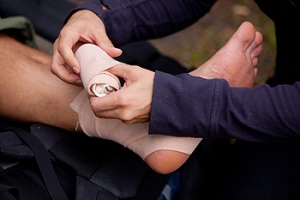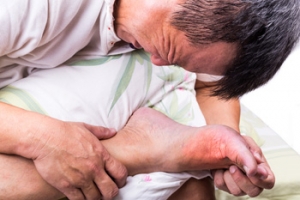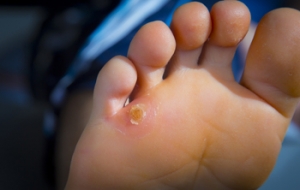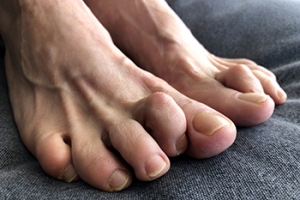
What Happens if You Don’t Treat an Ankle Sprain?
 Ankle sprains are one of the most common foot and ankle injuries that podiatrists treat. They occur when one or more ligaments in the ankle are overstretched or torn. If you have sprained your ankle, it is suggested that you seek treatment, particularly if the sprain is moderate or severe. Leaving an ankle sprain untreated can have potentially lifelong consequences. An untreated ankle sprain can lead to weakness in the ankle joint, causing chronic pain and ankle instability that makes repeated injuries more likely. Soft tissues in your ankle could also become trapped between the injured ligament and a bone, resulting in further pain, weakness, and difficulty walking. Swelling caused by an ankle sprain may damage surrounding nerves, muscles, and blood vessels if left untreated. If you have sprained your ankle, please seek the care of a podiatrist.
Ankle sprains are one of the most common foot and ankle injuries that podiatrists treat. They occur when one or more ligaments in the ankle are overstretched or torn. If you have sprained your ankle, it is suggested that you seek treatment, particularly if the sprain is moderate or severe. Leaving an ankle sprain untreated can have potentially lifelong consequences. An untreated ankle sprain can lead to weakness in the ankle joint, causing chronic pain and ankle instability that makes repeated injuries more likely. Soft tissues in your ankle could also become trapped between the injured ligament and a bone, resulting in further pain, weakness, and difficulty walking. Swelling caused by an ankle sprain may damage surrounding nerves, muscles, and blood vessels if left untreated. If you have sprained your ankle, please seek the care of a podiatrist.
Although ankle sprains are common, they aren’t always minor injuries. If you need your ankle injury looked at, contact Naim G. Shaheed, DPM from Ankle and Foot Centers of Georgia. Our doctor can provide the care you need to keep you pain-free and on your feet.
How Does an Ankle Sprain Occur?
Ankle sprains are the result of a tear in the ligaments within the ankle. These injuries may happen when you make a rapid shifting movement while your foot is planted. A less common way to sprain your ankle is when your ankle rolls inward while your foot turns outward.
What Are the Symptoms?
- Pain at the sight of the tear
- Bruising/Swelling
- Ankle area is tender to touch
- In severe cases, may hear/feel something tear
- Skin discoloration
Preventing a Sprain
- Wearing appropriate shoes for the occasion
- Stretching before exercises and sports
- Knowing your limits
Treatment of a Sprain
In many cases, the RICE method (Rest, Ice, Compression, and Elevate) is used to treat ankle sprains. However, you should see a podiatrist to see which treatment option would work best with your injury. In severe cases, surgery may be required.
It is important to ask your doctor about rehab options after you receive treatment for your injury. Stretching, strength training, and balance exercises may help the ankle heal while also preventing further injury.
If you have any questions, please feel free to contact one of our offices located in Lithonia/Stonecrest and Emory/Midtown, GA . We offer the newest diagnostic and treatment technologies for all your foot care needs.
Ankle Sprains
Although ankle sprains may not be as serious as a broken ankle, they should be given immediate attention and care. An ankle sprain can lead to a significant amount of pain, as well as limited mobility. They are often characterized by the swelling and discoloration of the skin. This occurs when the ligaments are stretched beyond their limits.
The simple act of walking can sometimes cause a sprain, which makes ankle sprains a very common injury that can happen to anyone. They occur when the ankle twists in an awkward way or rolls over itself, causing a pop or snap in the tendons around the ankle. Some people are more at risk than others. These include athletes who continually push their bodies to the limits and also people who have previously suffered accidents to the feet, ankles, or lower legs.
Most of the time, an ankle sprain is not severe enough for hospital attention. There are many at-home treatment options available, including propping the leg up above your head to reduce blood flow and inflammation, applying ice packs to the affected area as needed, taking over-the-counter pain relievers and anti-inflammatory medication, using an ACE bandage to wrap and support the injured ankle, and most importantly, remaining off your feet until the ankle has fully healed.
Despite this, an ankle sprain can turn into a severe injury that might require hospitalization. If the ankle ligaments or muscles are damaged from a tear or rip, that is one sign that the sprain is severe enough for hospital attention and possibly for surgery. Even after the surgery, the recovery process can be long. You may need to have rehabilitation sessions administered by your podiatrist to get your ankle back to full health.
The severity of your sprain might become apparent if you are unable to stand or walk, consistent pain occurs over a prolonged period of time, swelling is much more severe than initially present, or if you start to experience tingling or numbness. These signs may indicate that your ankle sprain might actually be a broken ankle, an injury that requires immediate medical attention.
Although they are not completely avoidable, ankle sprains can be curbed with some preventative treatment measures. These include wearing appropriate-fitting shoes that not only provide a comfortable fit, but also ankle support. It is also recommended to stretch before doing any kind of physical activity, as this will help lower your body’s chance for an injury.
What Is Medial Tibial Stress Syndrome?
Medial tibial stress syndrome (MTSS), more commonly known as shin splints, is an injury to the shin bone that occurs due to excess pressure being placed on it during physical activity. Shin splints are characterized by pain, tenderness, or soreness on the inside of the lower leg bone, particularly during exercise. Shin splints are typically treated through conservative methods. You may be encouraged to rest the injured leg, taking pressure off of it and giving it time to heal. Applying ice to the affected leg and taking over-the-counter medications can help reduce pain. Doing strengthening and stretching exercises may also help. To prevent shin splints, you should make sure that your shoes fit well and are supportive. When exercising, increase the length and intensity of your workouts slowly over time to avoid placing too much stress on the shin bones. For more information about shin splints, please consult with a podiatrist.
Sports related foot and ankle injuries require proper treatment before players can go back to their regular routines. For more information, contact Naim G. Shaheed, DPM of Ankle and Foot Centers of Georgia. Our doctor can provide the care you need to keep you pain-free and on your feet.
Sports Related Foot and Ankle Injuries
Foot and ankle injuries are a common occurrence when it comes to athletes of any sport. While many athletes dismiss the initial aches and pains, the truth is that ignoring potential foot and ankle injuries can lead to serious problems. As athletes continue to place pressure and strain the area further, a mild injury can turn into something as serious as a rupture and may lead to a permanent disability. There are many factors that contribute to sports related foot and ankle injuries, which include failure to warm up properly, not providing support or wearing bad footwear. Common injuries and conditions athletes face, including:
- Plantar Fasciitis
- Plantar Fasciosis
- Achilles Tendinitis
- Achilles Tendon Rupture
- Ankle Sprains
Sports related injuries are commonly treated using the RICE method. This includes rest, applying ice to the injured area, compression and elevating the ankle. More serious sprains and injuries may require surgery, which could include arthroscopic and reconstructive surgery. Rehabilitation and therapy may also be required in order to get any recovering athlete to become fully functional again. Any unusual aches and pains an athlete sustains must be evaluated by a licensed, reputable medical professional.
If you have any questions please feel free to contact one of our offices located in Lithonia/Stonecrest and Emory/Midtown, GA . We offer the newest diagnostic and treatment technologies for all your foot and ankle needs.
Sports Related Foot And Ankle Injuries
Foot and ankle injuries are common among people who participate in sports. Several factors contribute to this. They include failing to stretch or warm up properly, not wearing the proper type of shoe and not taping or providing other types of support for the ankle or foot. The most common foot and ankle injuries suffered by people involved in sports are plantar fasciitis, ankle sprains and Achilles tendon damage or ruptures. If not treated properly, they can lead to permanent disability.
Treating these injuries is relatively simple if they are identified and addressed early. Many athletes dismiss the initial aches and pains associated with injury as just soreness or tired muscles. Their first response is usually to try to work through it. This can lead to serious problems. Many minor injuries are made far more serious when athletes continue to put strain and pressure on them. That attitude can change a mild strain into a serious strain and a minor tear into a rupture. Athletes should have unusual aches and pains evaluated by a skilled medical professional.
Plantar fasciitis is a painful injury. It is inflammation of the plantar fascia, the thick band of tissue running from the heel to the base of the toes. If left untreated, it can lead to a degenerative disease called plantar fasciosis. There are several effective treatments for this ailment. Doctors often prescribe rest, massages, stretching, night splints, physical therapy, anti-inflammatory medication, corticosteroids or surgery, usually in that order. The most effective treatment for plantar fasciitis is orthotics, which offers foot support. Surgery is occasionally used as a last resort, but it comes with the risk of nerve damage and infection and often does not stop the pain.
The Achilles tendon is the largest tendon in the body. It connects the calf muscles to the heel bone. Running, jumping and walking all impact this tendon. Two common injuries to the Achilles tendon are tendonitis and a rupture of the tendon. Tendonitis is inflammation in the tendon often caused by an increase in the amount of stress placed on it. Non-surgical treatments include rest, ice or anti-inflammatory medication. A rupture (tear) of the Achilles tendon can be treated by placing the lower leg in a cast for several weeks or with surgery. Many physicians feel surgery is the better option because it lowers the risk of re-ruptures. Both methods require 4 to 6 months of rehabilitation.
Ankle sprains are the most common sports related foot and ankle injury. A sprain occurs when the ligament holding the ankle bones and joint stretches beyond its normal range. It can be treated non-surgically with a combination of rest, ice wrapped around the joint for 30 minutes immediately after injury, compression by a bandage and elevating the ankle above the heart for 48 hours. This combination is referred to as RICE. Severe ankle sprains in which the ligaments are torn may require reconstructive surgery followed by rehabilitation.
What Causes a Buildup of Uric Acid and Gout?
 Gout, a type of arthritis that often affects the feet and toes, is caused by a buildup of uric acid in the bloodstream. About two-thirds of uric acid in the blood occurs naturally in the body, a product of the breakdown of cells. One-third of uric acid comes from eating foods that contain purines, chemicals that create uric acid as a byproduct when the body metabolizes them. When your body has high levels of uric acid, this substance can crystallize and lodge in your joints, causing painful gout flare-ups. Gout pain is typically sudden and severe, centered on an inflamed and swollen joint. If you have gout, it is suggested that you be under the care of a podiatrist.
Gout, a type of arthritis that often affects the feet and toes, is caused by a buildup of uric acid in the bloodstream. About two-thirds of uric acid in the blood occurs naturally in the body, a product of the breakdown of cells. One-third of uric acid comes from eating foods that contain purines, chemicals that create uric acid as a byproduct when the body metabolizes them. When your body has high levels of uric acid, this substance can crystallize and lodge in your joints, causing painful gout flare-ups. Gout pain is typically sudden and severe, centered on an inflamed and swollen joint. If you have gout, it is suggested that you be under the care of a podiatrist.
Gout is a painful condition that can be treated. If you are seeking treatment, contact Naim G. Shaheed, DPM from Ankle and Foot Centers of Georgia. Our doctor will treat your foot and ankle needs.
What Is Gout?
Gout is a form of arthritis that is characterized by sudden, severe attacks of pain, redness, and tenderness in the joints. The condition usually affects the joint at the base of the big toe. A gout attack can occur at any random time, such as the middle of the night while you are asleep.
Symptoms
- Intense Joint Pain - Usually around the large joint of your big toe, and it most severe within the first four to twelve hours
- Lingering Discomfort - Joint discomfort may last from a few days to a few weeks
- Inflammation and Redness -Affected joints may become swollen, tender, warm and red
- Limited Range of Motion - May experience a decrease in joint mobility
Risk Factors
- Genetics - If family members have gout, you’re more likely to have it
- Medications - Diuretic medications can raise uric acid levels
- Gender/Age - Gout is more common in men until the age of 60. It is believed that estrogen protects women until that point
- Diet - Eating red meat and shellfish increases your risk
- Alcohol - Having more than two alcoholic drinks per day increases your risk
- Obesity - Obese people are at a higher risk for gout
Prior to visiting your podiatrist to receive treatment for gout, there are a few things you should do beforehand. If you have gout you should write down your symptoms--including when they started and how often you experience them, important medical information you may have, and any questions you may have. Writing down these three things will help your podiatrist in assessing your specific situation so that he or she may provide the best route of treatment for you.
If you have any questions, please feel free to contact one of our offices located in Lithonia/Stonecrest and Emory/Midtown, GA . We offer the newest diagnostic and treatment technologies for all your foot care needs.
Gout
Gout is a form of arthritis that is caused by a buildup of uric acid crystals in the joints. This considered to be one of the most frequently recorded medical illnesses throughout history. Gout occurrences in the US have risen within the past twenty years and the condition now affects 8.3 million people which is 4% of all Americans. Researchers have found that gout affects men more than women and African-American men more than white men.
Symptoms of gout are warmth, swelling, discoloration, and tenderness in the affected joint area. The small joint on the big toe is the most common place for a gout attack to occur.
People who are obese, gain weight excessively, drink alcohol heavily, have high blood pressure, or have abnormal kidney function are more likely to develop gout. Furthermore, certain drugs and diseases are likely to increase levels of uric acid in the joints which eventually leads to gout. You are also more likely to develop gout if you eat a lot of meat and fish.
Many who experience gout attacks will experience repeated attacks over the years. Some people who have gout symptoms, may never have them again, but others may experience them several times a year. If you have gout symptoms throughout the year, you may have recurrent gout. Those who have gout should also be careful about their urate crystals collecting in their urinary tract, because this may lead to kidney stones.
Diagnosis for gout is done by checking the level of uric acid in the joints and blood. Your podiatrist may also prescribe medicine to reduce uric acid buildup in the blood, which will help prevent any gout attacks.
To treat gout, your podiatrist may also prescribe you Anti-inflammatory medication (NSAIDs) which will relieve the pain and swelling of a gout episode and it can also shorten a gout attack. Maintaining a healthy diet is also a proven method to prevent gout attacks.
How Corns and Calluses Form
 After standing or walking for a significant amount of time, areas of the feet’s skin begin to thicken as a protective measure that allows them to withstand pressure. These thicker areas of skin form corns or calluses, which specifically protect the skin when it rubs against the ground, a shoe, or a bone. Footwear that doesn’t fit correctly, a bone deformity, or a poor walking style can lead to calluses, which are larger hardened areas of skin that don’t have a regular shape. Corns, on the other hand, tend to be much smaller and have a central core. There are 5 types of corns that are likely to form. These include hard corns, seed corns, vascular corns, fibrous corns, and soft corns. Each of these corns can have a different effect on the feet. If corns or calluses are pestering your feet, it is a good idea to consult a podiatrist who can help uncover the reasons behind them and suggest treatment options.
After standing or walking for a significant amount of time, areas of the feet’s skin begin to thicken as a protective measure that allows them to withstand pressure. These thicker areas of skin form corns or calluses, which specifically protect the skin when it rubs against the ground, a shoe, or a bone. Footwear that doesn’t fit correctly, a bone deformity, or a poor walking style can lead to calluses, which are larger hardened areas of skin that don’t have a regular shape. Corns, on the other hand, tend to be much smaller and have a central core. There are 5 types of corns that are likely to form. These include hard corns, seed corns, vascular corns, fibrous corns, and soft corns. Each of these corns can have a different effect on the feet. If corns or calluses are pestering your feet, it is a good idea to consult a podiatrist who can help uncover the reasons behind them and suggest treatment options.
If you have any concerns regarding your feet and ankles, contact Naim G. Shaheed, DPM of Ankle and Foot Centers of Georgia. Our doctor will treat your foot and ankle needs.
Corns: What Are They? and How Do You Get Rid of Them?
Corns can be described as areas of the skin that have thickened to the point of becoming painful or irritating. They are often layers and layers of the skin that have become dry and rough, and are normally smaller than calluses.
Ways to Prevent Corns
There are many ways to get rid of painful corns such as wearing:
- Well-fitting socks
- Comfortable shoes that are not tight around your foot
- Shoes that offer support
Treating Corns
Treatment of corns involves removing the dead skin that has built up in the specific area of the foot. Consult with Our doctor to determine the best treatment option for your case of corns.
If you have any questions please feel free to contact one of our offices located in Lithonia/Stonecrest and Emory/Midtown, GA . We offer the newest diagnostic and treatment technologies for all your foot and ankle needs.
Corns: What Are They, and How Do You Get Rid of Them
Corns are thickened areas on the skin’s surface, to the point of being irritating and sometimes painful. Commonly found on the feet, corns are circular or cone-shaped. They develop where there are areas of pressure or friction, such as on the little toe when it rubs up against shoes, or on the ball of your foot.
Corns are often confused with a callus, but there is a difference between them. Corns can be raised bumps that are painful to the touch. They consist of a rough, thick area of skin that may be dry or waxy. Corns tend to be surrounded by skin that is inflamed, and are usually much smaller than calluses.
Removing the dead skin that has built up is the key in treating corns. Salicylic acid medication is most common in accomplishing this. The acid works by dissolving keratin, which is the protein that makes up the majority of corns. You can purchase salicylic acid over-the-counter in products such as wart removers. It comes in a variety of forms such as medicated pads, drops, or creams. However, people who are diabetic should not use salicylic acid, but should instead consult their doctor immediately.
According to the product directions, applying the medication directly onto the corn will treat it. The top layer of the corn will begin to turn white after use. When that occurs, the layers of skin can then be peeled away, making the corn smaller. Shaving off corns with razors or other pedicure equipment is never a good idea. This can lead to infection. If your corn gets infected, and is not treated immediately, a visit to the doctor will be necessary.
Another way to treat corns and help prevent their return is by using orthotic inserts, fitted by a podiatrist. Inserts fit right into your shoes and adjusts the way your foot fits into your shoes. This fixes the way you walk. This will lower your chances of getting corns, and eliminate current corns by reducing rubbing from friction.
Surgery is rarely used to treat corns, but does occur on occasion. Surgery actually deals with the underlying issue that causes corns. During surgery, the bone is shaved and any abnormalities are corrected, thus reducing the amount of friction that occurs during walking.
To prevent corns, the first step is reducing friction. Always wear shoes that fit well and don’t rub your feet. Pads can be purchased if you notice rubbing developing. These pads can be purchased over-the-counter, and can be simply placed on the irritated area. Wearing cushioned insoles in your shoes can always reduce the friction, and making sure to wear well-fitting shoes. This will ensure that your foot is not being squeezed awkwardly, and prevent corns from forming in the first place.
Living With Hammertoe
 Hammertoe is a common foot deformity in which one or more of the smaller toes bend downward at the middle joint. Over time, the affected joints become stiff and difficult or even impossible to move. The tops of the affected toes can develop corns, blisters, and calluses from rubbing up against your shoes, causing pain and making it difficult to find proper footwear. Hammertoe is progressive, meaning it gets worse over time when it is left untreated. When caught in its earlier stages, hammertoe can be treated with conservative methods. These include wearing comfortable, properly fitted shoes, wearing orthotic inserts, and padding the affected toes to prevent skin irritation. For more information about hammertoe, please consult with a podiatrist.
Hammertoe is a common foot deformity in which one or more of the smaller toes bend downward at the middle joint. Over time, the affected joints become stiff and difficult or even impossible to move. The tops of the affected toes can develop corns, blisters, and calluses from rubbing up against your shoes, causing pain and making it difficult to find proper footwear. Hammertoe is progressive, meaning it gets worse over time when it is left untreated. When caught in its earlier stages, hammertoe can be treated with conservative methods. These include wearing comfortable, properly fitted shoes, wearing orthotic inserts, and padding the affected toes to prevent skin irritation. For more information about hammertoe, please consult with a podiatrist.
Hammertoes can be a painful condition to live with. For more information, contact Naim G. Shaheed, DPM of Ankle and Foot Centers of Georgia. Our doctor will answer any of your foot- and ankle-related questions.
Hammertoe
Hammertoe is a foot deformity that occurs due to an imbalance in the muscles, tendons, or ligaments that normally hold the toe straight. It can be caused by the type of shoes you wear, your foot structure, trauma, and certain disease processes.
Symptoms
- Painful and/or difficult toe movement
- Swelling
- Joint stiffness
- Calluses/Corns
- Physical deformity
Risk Factors
- Age – The risk of hammertoe increases with age
- Sex – Women are more likely to have hammertoe compared to men
- Toe Length – You are more likely to develop hammertoe if your second toe is longer than your big toe
- Certain Diseases – Arthritis and diabetes may make you more likely to develop hammertoe
Treatment
If you have hammertoe, you should change into a more comfortable shoe that provides enough room for your toes. Exercises such as picking up marbles may strengthen and stretch your toe muscles. Nevertheless, it is important to seek assistance from a podiatrist in order to determine the severity of your hammertoe and see which treatment option will work best for you.
If you have any questions, please feel free to contact one of our offices located in Lithonia/Stonecrest and Emory/Midtown, GA . We offer the newest diagnostic and treatment technologies for all your foot care needs.
















